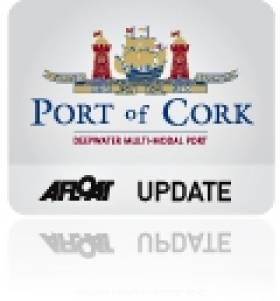Displaying items by tag: Mr Dermot O'Mahoney
Port of Cork Traffic Up 10% in 2010
While all sectors at the Port of Cork experienced a challenging period during 2010, the end of year total trade traffic shows an increase. Total trade in 2010 through the Port of Cork amounted to 8.8 million tonnes, an increase of 8.6% compared to 2009.
One area of increase which has a very positive effect on the local economy is the increase in exports from the Port. Total exports at the Port of Cork have remained strong increasing by 10% to date, in comparison to 2009. Exports are a key driver in the successful recovery of the Irish Economy and the Port of Cork is committed to continuous support in the growth of international trade for both current and future economic prospects.
The container business at the Port of Cork has remained constant with over 150,000 TEU handled in 2010. Animal feed stuffs, fertiliser and other trades have shown a significant increase in 2010. Oil traffic has shown a slight increase of 3.5% as a consequence of lower levels of economic activity; however it continues to be a significant part of the Port of Cork business.
Commenting on the end of year trade traffic results, Mr Dermot O'Mahoney Chairman of the Port of Cork said: "The Port of Cork is pleased to announce that total trade traffic in 2010 has shown an 8.6 % increase on 2009 traffic. With 98% of all goods imported or exported from Ireland moved by ship, the importance of ports to our economy is vital. The Port of Cork is a key link to the continued economic success of the entire Munster region and the challenges now for the Port of Cork, is to continue to develop. This requires that we be visionary and seize opportunities presented by emerging trends and logistic supply changes."
He continued: "While the next four to five years will be challenging for us all, we need to continue to promote the fact that Ireland is an excellent investment location and is well placed to capitalise on growing global markets."
52 cruise liners visited the Port of Cork during 2010 bringing over 100,000 passengers and crew to the region. According to research carried out by UK consultants GP Wild, the average in-transit spend per passenger, while visiting an Irish port is €73. This is a significant contribution towards the local tourism economy.
Ferry passenger numbers though the port also increased mainly due to the welcomed re-commencement of the ferry service linking Cork with Swansea. The weekly ferry service from Cork to Roscoff with Brittany Ferries also had a successful year.
In 2010, the Port of Cork developed a recreational strategy to improve the marine leisure facilities around Cork Harbour. The first project carried out was the construction of a 100m marina on South Custom House Quay. This long term investment for the city of Cork has already proven to be very popular among local boats and visiting boats. The Port of Cork expects 2011 to be even busier.
























































